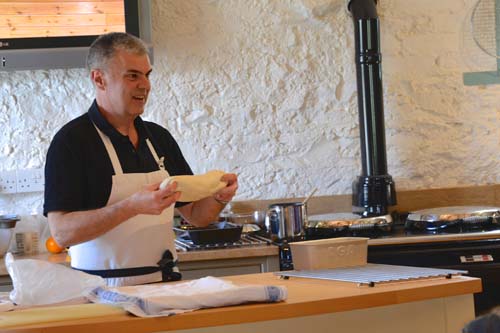Cooking on the AGA
The same but different!
People worry they'll have to learn to cook again - don't!
A couple of techniques to slightly alter but there's nothing to be afraid of, in fact most things are easier and you'll get better results than an ordinary oven.

The two main differences
1. Fixed temperature ovens
Alter the oven you use instead of the temperature dial.
AGAs have two, three, four or five ovens and they're all at different temperatures (see below for how the AGA works to learn why). Conventional cookers use one oven and change the temperature, with the AGA just use the oven that's at the temperature you need. Cooking times don't change.
2. Oven Cooking
The AGA is a 'heat storage' cooker so it's best to use the ovens as much as possible - retaining heat and using less energy than open hob cooking.
You'll be surprised at just how much you can do in the oven instead of on the hob.
That's essentially it!
With a couple of small changes your cooking is transformed - great results every time!
Read on for a more detailed explanation.
The Basics of Cast-Iron Heat-Storage Cooking
A brief history
When cooking was done over an open fire there wasn't much you could do to alter the heat other than move things further away. Heat was quickly lost if you didn't keep up with the fire and feeding the household was a hard, messy job.
Fortunately we've come a long way since then!
The 'kitchen range' came along with its side-oven allowing baking and a little control over temperatures - but still an open fire with very poor efficiency and the control you did have was limited and very labour-intense. (And a kitchen range was still a rather exclusive item.)
Improving on the open-fire heated range the AGA was born. Invented by Dr Gustav Dalen, a Nobel-prize winning scientist who decided that enclosing the fire would be safer (he'd lost his sight in an experiment), more controllable and more efficient.
He was right - less fuel was needed and there was much more control over the temperature of the cooker.

Fixed Temperatures
The 'Traditional' AGA uses heat from a single source (keeping things simple: one burner, one flue, one set of workings and controls) to heat the hotplates and ovens to different temperatures using cleverly designed flue/ducting and cast-iron conduction plates which ensure the correct temperatures are maintained throughout.
(Incidentally - we now refer to all these 'single heat-source' models as 'Traditional AGAs'. The New Generation AGAs have separate controls for hotplates and ovens but the fixed temperature principle is the same.)
You then have ovens and hotplates with different cooking temperatures - always ready to roast, bake, simmer or boil, anytime of day or night with the bonus of a gentle warmth emitted to the room from the hard-wearing vitreous enamel top and front of the cooker.
How does this affect cooking?
Well, rather than use the same oven but change its temperature setting (as you would on a conventional gas or electric oven), you just use the oven which is already at the correct heat: want to roast? Use the top (hottest) oven, bake? Use the more moderate oven and for simmering use the bottom oven.
Cooking times stay the same, but instead of changing the oven temperature you use whichever oven suits the temperature you need.

The AGA Cast-iron top oven
Hotplate Cooking

Quick cooking with a high heat - steak on the AGA hotplate.
Again the 'fixed temperature' principle applies - there's a boiling plate for intense cooking and starting things off, and simmering plate for slower or more moderate cooking.
To alter the temperature: instead of turning a burner or zone up or down as you do on a conventional hob you just move the pan so there's less contact with the hotplate - it's as easy as that.
The 80-20 rule
Conventional hob/oven cooking often results in 80 percent of the cooking being done on the hob, and 20 percent in the oven. In an AGA this is generally reversed.
Most things that would simmer on a hob or cook for a long time (generally longer than 10-15 minutes) can be cooked in the AGA's bottom (or 'Simmering') oven: rice, root vegetables, risotto, porridge and many other dishes can be done this way using its gentle heat.
Prefer Electric to Gas?
It doesn't matter with the AGA - you're cooking using the radiant heat from the cast iron.
There's no exposed flame in the oven so the type of heat is the same in all AGAs - solid fuel, gas, oil, electic, 'Traditional' or 'New Generation' - they're all the same.
New Generation AGAs
AGA Total Control
AGA Dual Control
AGA 60 and AGA 3 Series
In 2011 the AGA Total Control was launched, the AGA Dual Control followed in 2013 and AGA 60 in 2014.
In 2018 we have the AGA 3 Series 'Everyday' Cookers.
How are they different?
It's the controls that are different - depending on which you have you can control the ovens and hotplates individually, or run the cooker in an ultra-low heat mode (much less heat to the room for summer and very low running costs).
Is the Cooking Different?
These New Generation models have separate controls for the hotplates and ovens but use AGA's famous cast-iron ovens and hotplates so they cook in just the same way as all heat-storage AGAs have - with radiant heat to seal in flavour.
This means the cooking principles and styles (constant temperatures and oven-cooking) remain the same.







